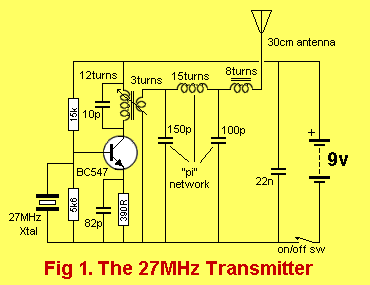-
Posts
749 -
Joined
-
Last visited
Never
Content Type
Profiles
Forums
Events
Posts posted by walid
-
-
-
I appeal to my friend audioguru to respond to the subject
I waited for his reply for more than a week
Thanks -
My questions are:
1)Are these calculations are true in general?
2) Why '2' in 2.Po = [Vcc-Ve]^2/R, i learn that P = V^2/R
3)Why [Vcc-Ve]^2, I think it must be [Vcc-Vc]^2
Eagerly awaiting your reply
Thanks
I discover the answer of the second question: the RMS value of the peak voltage = Vpeak/squre root of 2
and when we squre that root we get 2 which appear in the equation.
i need answer to question 3
thank you very much -
Hello guys
In the following link,
http://www.electronics-tutorials.com/amplifiers/negative-feedback.htm
the author speaks about how to made the necessary calculations to determine the transformer's turns ratio and also the LC needed for impedance matching a 50-ohm antenna to the preceding stage
Regardless of some of the details that the writer is talking about, espicially his talking about the dc biasing and the o/p voltage swing, I will focus in the discussion with you on the method of calculating the turns ratio.
Look at the fig:
the author said: Here we are only mainly concerned here with the principle of a tuned circuit as a load. In this example we have a final load of 50 ohms connected to the output link coupling of our tuned circuit. Assume, just for discussion purposes, that in this example we needed a power output of 100 milliwatt from the amplifier and that we have available a power supply of 12V. Further,
Here we are only mainly concerned here with the principle of a tuned circuit as a load. In this example we have a final load of 50 ohms connected to the output link coupling of our tuned circuit. Assume, just for discussion purposes, that in this example we needed a power output of 100 milliwatt from the amplifier and that we have available a power supply of 12V. Further,
Now:
2 * Po = [Vcc - Ve]^2 / R
or [2* 0.1] = [12 - 3.22]^2 / R
or [2* 0.1] = [ 8.78 ]^2 / R
and R = 77 / 0.2
= 385 ohms
Therefore the load presented to the output of our amplifier needs to be 385 ohms. The impedance ratio is 385 / 50 or 7.7:1 and the turns ratio on the transformer (inductor) is the square root of that number or 2.775:1.
My questions are:
1)Are these calculations are true in general?
2) Why '2' in 2.Po = [Vcc-Ve]^2/R, i learn that P = V^2/R
3)Why [Vcc-Ve]^2, I think it must be [Vcc-Vc]^2
Eagerly awaiting your reply
Thanks
-
Hi Guru
Thank you for attention
What do you think of this circuit
from: http://www.talkingelectronics.com/projects/27MHz%20Transmitters/27MHzLinks-1.html
The author use a transformer then PI network filter for impedance matching the low Z antenna (50 ohm) to the very high (near infinity) Z tank circuit.
I am a week ago, trying to understand, and I hope that you help me to understand
Thanks -
A 1k load would be much too low.
what to do if the load is 1k only??
Do I have to replace the coil with a stepdown RF transfrmer?? -
Any load connected to the output will reduce the amplitude and stability of the oscillator because it will affect the Q of the resonant circuit
What the solution then??
Do I have to replace the coil with a stepdown RF transfrmer??
What is the turn ratio then if i want to match with 100K ohm load?
thank you in advance. -
thank you guru
Be sure that the resonance freq is 27MHzbut if it is 27mHz then it is an extremely high impedance
is the Zout = XC//XL; the parallel equivalent of the two reactancess (coil and ca)???
regards -
Hello guys
The attached photo is a crystal oscillator
it is a voltage divider config. but replacing the RC with LC tuning tank
I need to know the out put impedance Zout??
Is it XC// XL at the operation freq 27MHz???
please help me
thank you in advancehttp://NOTE: sorry L= 3.48 uH not 1.2 uH as in the circuit
-
It is a great loss
-
We have discussed several subjects did not find an old
Please help -
Thank you KevinIV for reply
my question is why and how filter amplify signals?? -
Hellow,
I build the following pi filter to match 100 ohm source to 1000 ohm load, I did the calculations based on RF Circuit Design Book
As u can see at the center freq fc = 30MHz & Q=15 I had 3.771dB, I was surprised by where this value? this is amplification!!!!
The second question is: If i want to match 1000 ohm source to 100 ohm load, Simply replace the capacitors, one must place the other, when i did so and simulate i had the following:
[img width=680 height=478]
Look!! -9.8dB at the center freq.
can you please comment, how to match big source to small load without that bad attenuation
thanks alot -
[glow=red,2,300]January 2007[/glow]
http://rapidshare.com/files/9994391/Jan07.pdf -
I am sorry, my dear Ante,the last issue I have is February 2007.
-
Hi Ann
I wish that the dialogue is always reply point by point. I spend a long time in the preparation of the question therefore hope that the reply on the points that I'm asking about them specifically and not a general answer.
The question that I wish to find a definitive answer for is : Why must know -ve resistance, and when necessary to developer in mind?
thanks -
Here is another one
http://www8.rapidupload.com/d.php?file=dl&filepath=39423 -
If this is not forbidden, I have many of them and I can give you for the benefit
-
I submit this electronic magazine as a gift to the best forum in the world
http://www8.rapidupload.com/d.php?file=dl&filepath=39239 -
I do not have the necessary equipment, but I submit this link to enrich the subject
http://www.giangrandi.ch/electronics/crystalfilters/xtaltest.html -
Hi
TO audioguru:The 'scope pic of the oscillator's output shows severe distortion that is cleaned up with the 3rd-order lowpass filter.
(a) Clear from your talk that you agree with AN920 that this is not good design.
(b)
I thought that it is banpass filter. i think it is 3rd order because it is 3 elements filter. Let me look at the internet for further information on this filter.3rd-order lowpass filter
TO AN920Many people get crystal oscillators to work by trial and error, not that I am suggesting that that was the case here.
I have long believed that many of the designs are in a trial and error because of the different specifications of some electronic components from each other.Another crystal of the same value in series on the output will produce a very good sine wave output with low harmonics.
(a) That is a very good and new idea, are you sure that Another crystal of the same value in series on the output work as lowpass filter?
(b) Can shed further light on the use of crystal as a LPF.
thanks GURU
thanks AN920 -
Thank you, I am very happy about your presence among us more than happy to answer, because I miss you and I intend to send a special message to you. I thank God that you are fine.
That is an extremely old circuit.
Possibilities in Canada very large, but in Palestine almost nothing, we are therefore interested in those circuits, which can be dealt with.
From the graph, I think it would be difficult to build a circuit to deal with temperature = 30 -
Hi
I found this circuit Saved in my PC (pdf formatt) and I do not know of any site obtained. This circuit uses a complementary pair comprising npn metallic transistor T1 (BC109) and pnp germanium transistor T2 (AC188) to detect heat (due to outbreak of fire, etc) in the vicinity and energise a siren. The collector of transistor T1 is connected to the base of transistor T2, while the collector of transistor T2 is connected to relay RL1.
This circuit uses a complementary pair comprising npn metallic transistor T1 (BC109) and pnp germanium transistor T2 (AC188) to detect heat (due to outbreak of fire, etc) in the vicinity and energise a siren. The collector of transistor T1 is connected to the base of transistor T2, while the collector of transistor T2 is connected to relay RL1.
This part is what concerns me nowThe second part of the circuit comprises popular IC UM3561 (a siren and machine-gun sound generator IC), which can produce the sound of a fire-brigade siren. Pin numbers 5 and 6 of the IC are connected to the +3V supply when the relay is in energised state, whereas pin 2 is grounded. A resistor (R2) connected across pins 7 and 8 is used to fix the frequency of the inbuilt oscillator. The output is available from pin 3.
This part does not really care because I will focus on how to use transistor as heat detector.
The writer wrote the following passage :To test the working of the circuit, bring a burning matchstick close to transistor T1 (BC109), which causes the resistance of its emitter-collector junction to go low due to a rise in temperature and it starts conducting. Simultaneously, transistor T2 also conducts because its base is connected to the collector of transistor T1. As a result, relay RL1 energises and switches on the siren circuit to produce loud sound of a firebrigade siren.
My question:
Is this talk true, I mean the resistance between collector and emitter is small at high temperature. Can this circuit activate the relay to operate at a temperature of 30 degrees Celsius for example?
My friend who owned Machine chicken breeding (breeding) of the locally-made and wants to operate some internal parts when a certain temperature, can this circuit be used instead of the temperature sensor which is already not available (HERE). Thanks
-
Hi An920
While I am looking into the Internet, I encountered the following firure from the Web site :
http://www.k8iqy.com/qrprigs/2n215/2n215page.htm
As you see in the picture C21 is less ten times than the upper C20, and this violates what we agreed upon in previous commentary.
I think that this design done by senior scientists.





about RX-3 IC
in Theory articles
Posted
Hello


frome the datasheet of RX-3 i get the following application circuit
and at the left side there is antenna and related component:
My question is what the purpose of the transistor Q1?
thank you